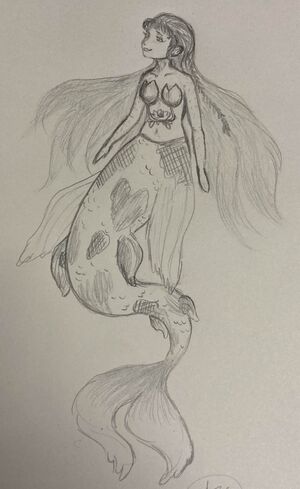Mermaid
| Mermaid | |
|---|---|

| |
| Koi Mermaid | |
| Scientific classification | |
| Kingdom: | |
| Division: | |
| Class: | |
| Family: | |
| Genus: | |
| Species: | |
| Binomial name | |
| Aquae Pulchrae A. Cambri and B. Devon
| |
The ‘’’Mermaid’’’ is one of the most famous and common of the Fābulae. Despite being adapted for a fully Aquatic lifestyle, mermaids are capable of surviving on land, albeit most mermaids do so in a fairly awkward manner, being forced to flop, roll, or crawl in most cases in order to move around.
Mermaids are primarily native to the Aquitaan and Magnumare seas, but the more adventurous variants have swum all over the world. Most, if not all, mermaids are loyal to the Drakon monarchs of Aquitinia, though few do much to act on these loyalties.
Mermaids come in a number of varieties. The most internationally well known forms are the shark forms, with the most common of these being the black and white tipped mermaids, though tiger sharks are also quite common. In freshwater environments catfish, sturgeon, and koi are the most famous forms of mermaids, though many other mermaids variants exist.
Mermaids are sometimes mistaken as obligate carnivores, but are known to be capable of consuming grains. However, most mermaids subsist almost entirely or only on meat. Their near immunity to diseases and poison allows them to easily consume creatures such as jellyfish, while also being able to hide among large quantities of jellyfish if something threatens them. Unfortunately for Sea Turtles, mermaids both outcompete them for much of the same food and actively will consume them, the advanced hands of the mermaids allowing them to easily manipulate the turtles to negate the defensive advantage of those animals.
Etymology
Mermaids derive their name from their appearance. “Mer-” derives from the word “Mere”, which refers to large bodies of water. The second part of their names, “-maid” is simpler, simply coming from the fact that all mermaids are female. They received their names from sapient landlubbers, who were amazed when they first saw the aquatic people.
History
Prehistory
The oldest records of mermaids date back to the Cambrian period, though these are very rare. Mermaid remains only became common during the Devonian period, during which they were obviously very abundant. However, little more than this can be said about Devonian era mermaids, as there is not sufficient evidence to say whether or not they were truly dominant at the time or simply common. Most arguments that claim mermaids to have been a dominant species in those periods revolve around their relative lack of competition, but many reject these arguments as being too speculative, since it is possible that the remains of their competitors have simply never been discovered. The mermaids, for their part, do not care about the debate.
One mystery is how the mermaids had reproduced, as none of the species that the parasitically reproducing species usually pairs with, such as humans and centaurs, are known to have existed at the time. So far no partner species has been discovered from the Cambrian or Devonian periods, leaving scores of scientists puzzled.
Ancient
(WIP)
Modern Living
(WIP)
Biology
Physiology
(WIP)
Reproduction and Maturation
(WIP)
Consumption
(WIP)
Society
(WIP)